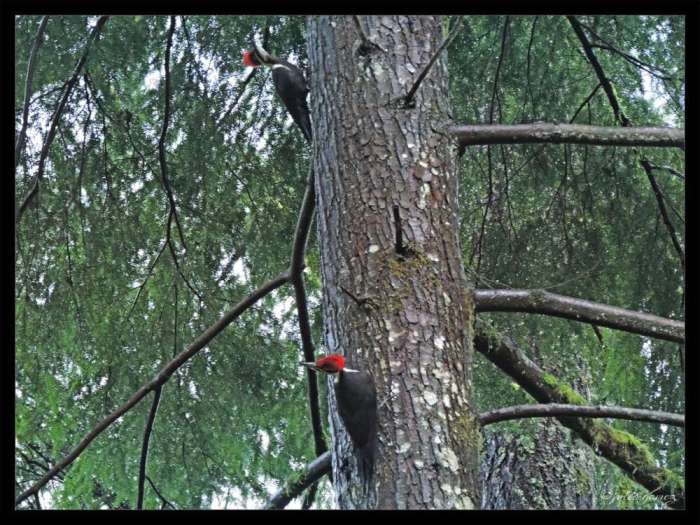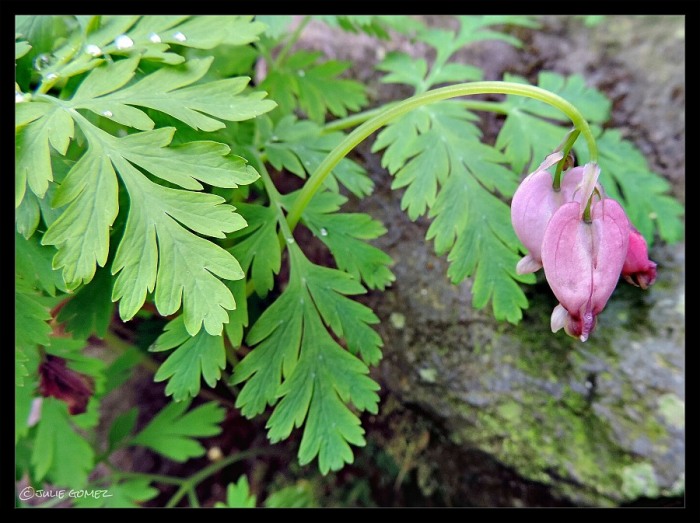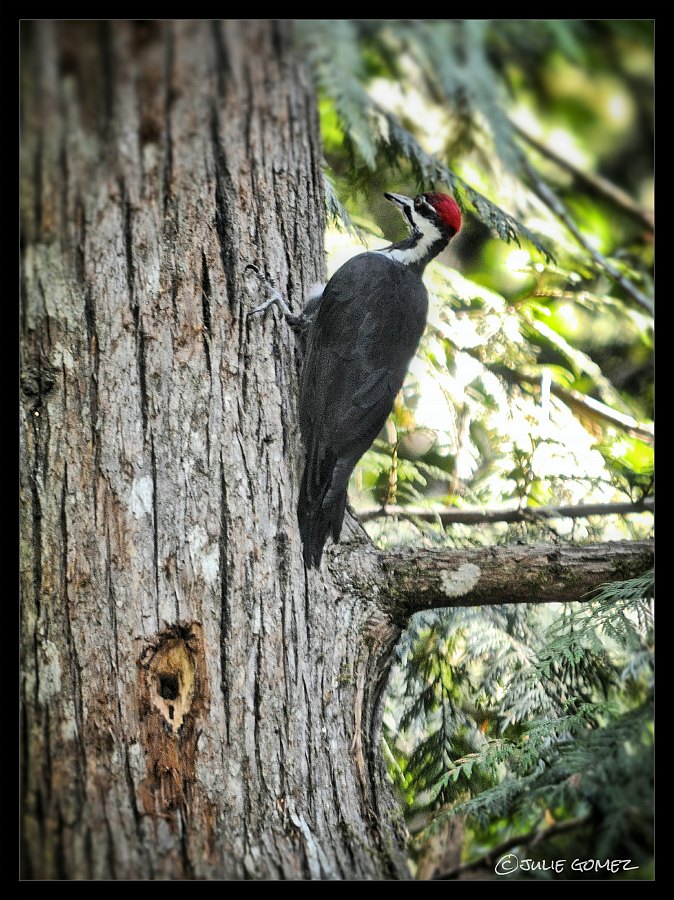
When a dead tree falls, the woodpeckers share in its death. —Malayan Proverb
🌿 🌿 🌿
The morning dawned with rain; a warm and gentle rain that bordered on drizzle. I’m used to the rain. In fact, much of the time I welcome it. In this temperate rainforest where we live, an average of 80 inches of liquid sunshine falls annually. It’s what keeps Oregon green! Don’t get me wrong, I love sunshine, but with all this rain, it makes me appreciate those sunny bluebird days all the more.
Rain or shine, most mornings the air smells like cottonwood spice; a sugary fragrance I happen to love, and this morning was no different. How delightful is the forest that smells of sweet rain and freshly turned earth after a dry spell. Overhead, the clouds brightened as the sun tried to break through. The forest looked so green and vibrant. Plants looked twice as large as they did the day before, their stems and buds glistening. Mosses went from dingy-yellow tufts to bright green cushions; having tripled in size, they dripped like wet sponges. Birds celebrated, and the woods came alive with their song.
While the coffee brewed, I opened the kitchen window to the stopper; it will now stay open until at least October. Part of my morning ritual is filling bird and squirrel feeders. And like most mornings, the Steller’s jays (five in all) were waiting at the glass door. It’s comical seeing them all standing in a row, cranking their necks to look inside. I took a handful of peanuts from the big red bucket that sits on the table next to the door, and stepped outside. The jays took flight; swooping and diving, making a racket with all their squawking that ended the harmony.
Of course, with all that jay noise the squirrels took notice, and came running. For a time, there was a bit of chaos as jay’s scolded squirrels, and squirrels scolded jays. Most mornings are like this until the peanuts are served. When all have gotten their share, things quiet down again.
After a cup of coffee, I head back outside; this time with my camera to shoot the Pacific bleeding heart (Dicentra formosa)—a native perennial that graces these woods each spring. The rain turned to drizzle, which added a nice luster to the heart-shaped blooms, and caused droplets to form like glass beads on the waxy leaves.

I didn’t mind the drizzle that fell gently on my shoulders. Bumblebees too, didn’t seem to mind and were intent in their quest for nectar and pollen. Then came a loud, but distant call. It was the call of the pileated woodpecker. Except for the Ivory-billed woodpecker, which may or may not be extinct, the pileated (being 17 to 19 inches in length) is the largest woodpecker in North America.
The call sounded again and again; each time a bit louder and closer. The call quickly multiplied in a series of flight calls, not one, not two, but three! The trio landed in the top of a tall bigleaf maple snag at the edge of our property along South Bank. There the Pileated’s ravaged the snag in search of bugs—poking and prodding the nooks and crannies. Their chatter or “interaction calls” was almost constant. Then they took flight! The Pileated’s flew closer, settling on a western hemlock also on South Bank. I could see that the birds were females all about the same size or roughly 17 inches. There was much wing flapping and chatter among them as they moved around and up the tree trunk. Apparently a healthy tree, there was no food to be had, and again they took flight.

They flew past on rapid wing beats and made shrieking calls only to land closer; this time just twenty-five yards away in a dying cedar tree that stands straight as an arrow in the side yard. Their calls burst with energy, and were near deafening. Again, the Pileated’s went round and round the tree. Their razor-sharp claws etched the bark and I could hear the hollowness within the tree. For the life of me, I don’t know what is holding this tree up; I’m just glad it’s still standing since it’s right next to our outbuilding. About twenty feet of the lower trunk is hollow from carpenter ants. They have turned its heartwood into sawdust. Fortunately for these woods, the carpenter ant is the Pileated’s favorite insect.
The Pileated’s feasted. Cedar chips were flying! My closeness didn’t seem to faze them. Perhaps they hadn’t seen me. Or maybe they were too busy to notice or care. Their calls continued. A lone Pileated is loud, but when three are carrying on . . . well, let’s just say I felt like I was in the jungles of the Amazon. I guess, in a sense, this temperate rainforest is my Amazon. It’s where rain and drizzle fall, and where plants grow tall and green; it’s where one can literally become lost and sometimes never found. It’s where the Pileated’s sing.
____________________
Copyright 2014. All rights reserved.
🌿Thank you for reading Nature Chronicles.
🌿Learn more and hear the calls of the pileated woodpecker

Julie, I found your blog by browsing your photos on Wunderground. That area looks really beautiful and you’ve captured the beauty there very well. I was wondering if you are still in the Welches area and how you like it there. My husband and I were looking at the Welches and Rhododendron area to relocate from Portland. We’re nature lovers and work from home so that area looks like a great location.
Hi Janet! And thank you! It’s wonderful here in the mountains. My husband and I have lived in the area for 17 years, and we love having nature at our doorstep. We do get a lot of rain up here, even when it’s not raining in Portland. In fact, it’s raining lightly right now, and it wasn’t even forecasted. Winters are rather long and very wet. Snow is usually not a problem, although some winters we’ve seen 2-3 feet in the foothills. (ODOT does however, maintains hwy. 26 very well.) We don’t have the best Internet service, but they’re working on it. And we lose power more than we like—the longest outage lasted 3-days in the dead of winter. But it’s all a part of mountain living—gotta love it! Welches is a wonderful community, and great place to live. Whatever your decision, I wish you the best of luck!
Your morning ritual with jays and squirrels is great, I can just picture them. So much like the same noisy camp robbers and Abert squirrels here in the Arizona mountains. Enjoyed every word.
Good morning, Maril! I just finished feeding them. It’s like they’ve never seen food before. Even Mr. Towhee gets in on the act. Never a dull moment around here, which keeps things interesting. Glad you enjoyed my post, and thanks for stopping by. 😊
Have a great day!
Thank you! You to, Maril!
Again Julie, another wonderful vignette of life and its magical aspects. Thank you.
Thank you, Thad. Each day spent in these woods is magical—always something worth noting. 😊